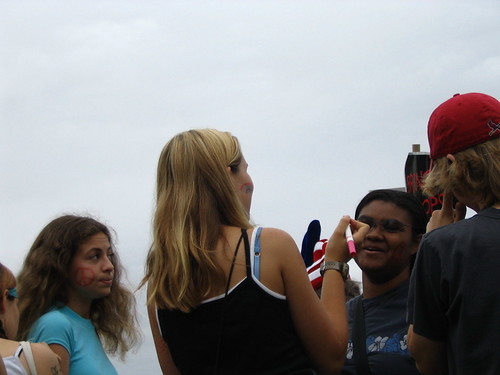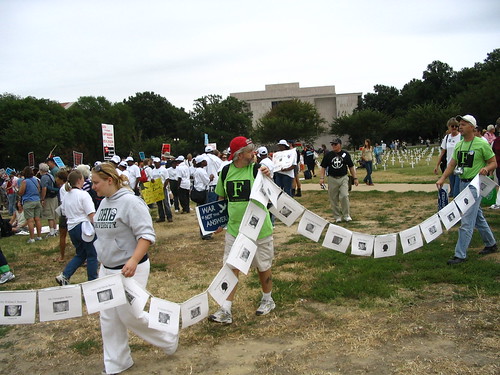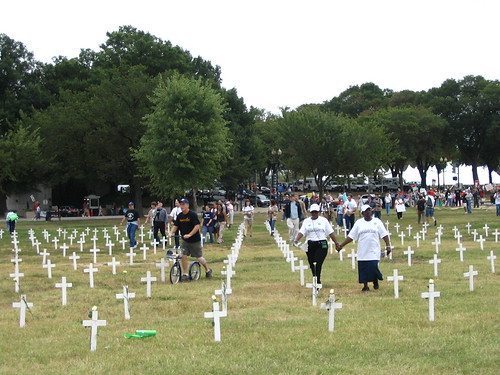Sunday, September 25, 2005
Corrective Emotional Experience
Looking through the photos that are available, so far, from the 9/24/2005
peace rally in Washington DC, it appears that three basic
themes predominate. One is the size of the crowd; another,
the intensity of expressed emotion; the third, the incidence of people
who dressed funny. The problem is, those three categories of
photo do not convey the core of the experience of being there; nor do
they capture what, to me, is the area of greatest human interest.
The crowd was massive. But early in the morning, the crowd was not so dense as to preclude freedom of movement. It even was possible for individuals and small groups to have moments of relative privacy. I noticed that people in general were aware when others were having an emotional moment, and respected the appropriateness of privacy and boundaries.
There were a lot of individuals who ended up having moments of intense feelings. I did not photograph any of those. Even if I had, I would not post them.
Those of you who have had emotional reactions, based upon the photos posted online so far, may be in need of a corrective emotional experience. Actually, come to think of it, that is not exactly the correct term to convey what I am trying to convey. It is not a formal term (yet), but I guess what I am thinking is that people may need a supplementary emotional experience. So here are three pictures to supplement what has been posted elsewhere.

One of the most important aspects of the experience of being at the rally, was the sharing that occurred in small groups. The photo above was taken while I was sitting on the ground, and I did not hold the camera up to my eye, so it is not framed very well. Even so, it captures a moment in the experience of a small group of young women....girls, I guess, if that term is still politically acceptable.

Another small group: these people were, I think, associated with Camp Casey. They made a lengthy chain with pictures of the troops who have died in combat. They later carried it along the march route. I'm reasonably sure that the experience of doing that was emotionally evocative for those who participated.

These are people ambulating among the crosses. Notice the couple holding hands. I'm sure they have a story to tell, although I have no idea what it is. Notice how the rest of the crowd was giving them some space. There must have been a reason for that.
I was not close enough to see the expressions on their faces, and did not want to be intrusive by waiting until I could get a good telephoto shot.
I did see a lot of individuals crying. One in particular, whom I would have liked to have photographed, was a youngish woman sitting on the ground, by a display of empty military footwear: boots on the ground. She was weeping quietly. People gave her the physical space to do so, granting that particular kind of privacy that one can sometimes get, even in the midst of a couple hundred thousand people.
My moment came when I happened to see a picture of a woman receiving a flag from an Army officer, during the course of a military funeral.
When I was 17, I was a bit of a jock, a teenage boy, not yet very aware of my own emotional states. My uncle, who had been in the Coast Guard during WWII, died. I was in a speech class at the time, and my family came to get me. They must have called the college to find out where I was. A couple of days later, I went to the funeral. I still remember the feeling of the cold steel of the coffin handle, having been one of the pallbearers.
Despite being an active participant in the ritual, I did not experience much emotion. Not much, that is, until the officer handed the flag to my aunt. She burst into tears. At that moment, I became a little bit more of an adult.
In my first post about the rally, I emphasized the need for people to get the pertinent information, and evaluate it individually, critically. Naturally, the raw data present only half the story. The emotional experience of being at the rally is the other half. Some of those emotions were shared among the crowd. But some were entirely private. Some had nothing to do with the stated purpose of the rally, or were related only peripherally.
In order to grow into adulthood, or to continue one's growth as an adult, we need to use our intuition to seek out those experiences that generate resonance in our emotional lives. Shielding yourself from such experiences is maladaptive. Dismissing the experiences of others is mean-spirited and unhelpful.
The crowd was massive. But early in the morning, the crowd was not so dense as to preclude freedom of movement. It even was possible for individuals and small groups to have moments of relative privacy. I noticed that people in general were aware when others were having an emotional moment, and respected the appropriateness of privacy and boundaries.
There were a lot of individuals who ended up having moments of intense feelings. I did not photograph any of those. Even if I had, I would not post them.
Those of you who have had emotional reactions, based upon the photos posted online so far, may be in need of a corrective emotional experience. Actually, come to think of it, that is not exactly the correct term to convey what I am trying to convey. It is not a formal term (yet), but I guess what I am thinking is that people may need a supplementary emotional experience. So here are three pictures to supplement what has been posted elsewhere.

One of the most important aspects of the experience of being at the rally, was the sharing that occurred in small groups. The photo above was taken while I was sitting on the ground, and I did not hold the camera up to my eye, so it is not framed very well. Even so, it captures a moment in the experience of a small group of young women....girls, I guess, if that term is still politically acceptable.

Another small group: these people were, I think, associated with Camp Casey. They made a lengthy chain with pictures of the troops who have died in combat. They later carried it along the march route. I'm reasonably sure that the experience of doing that was emotionally evocative for those who participated.

These are people ambulating among the crosses. Notice the couple holding hands. I'm sure they have a story to tell, although I have no idea what it is. Notice how the rest of the crowd was giving them some space. There must have been a reason for that.
I was not close enough to see the expressions on their faces, and did not want to be intrusive by waiting until I could get a good telephoto shot.
I did see a lot of individuals crying. One in particular, whom I would have liked to have photographed, was a youngish woman sitting on the ground, by a display of empty military footwear: boots on the ground. She was weeping quietly. People gave her the physical space to do so, granting that particular kind of privacy that one can sometimes get, even in the midst of a couple hundred thousand people.
My moment came when I happened to see a picture of a woman receiving a flag from an Army officer, during the course of a military funeral.
When I was 17, I was a bit of a jock, a teenage boy, not yet very aware of my own emotional states. My uncle, who had been in the Coast Guard during WWII, died. I was in a speech class at the time, and my family came to get me. They must have called the college to find out where I was. A couple of days later, I went to the funeral. I still remember the feeling of the cold steel of the coffin handle, having been one of the pallbearers.
Despite being an active participant in the ritual, I did not experience much emotion. Not much, that is, until the officer handed the flag to my aunt. She burst into tears. At that moment, I became a little bit more of an adult.
In my first post about the rally, I emphasized the need for people to get the pertinent information, and evaluate it individually, critically. Naturally, the raw data present only half the story. The emotional experience of being at the rally is the other half. Some of those emotions were shared among the crowd. But some were entirely private. Some had nothing to do with the stated purpose of the rally, or were related only peripherally.
In order to grow into adulthood, or to continue one's growth as an adult, we need to use our intuition to seek out those experiences that generate resonance in our emotional lives. Shielding yourself from such experiences is maladaptive. Dismissing the experiences of others is mean-spirited and unhelpful.
(Note: The Rest of the Story/Corpus Callosum has moved. Visit the new site here.)
E-mail a link that points to this post:
Comments:
Post a Comment



